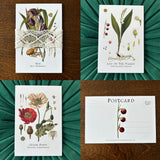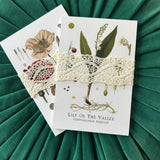Postcards featuring the collection of Deadly Nightshade Emporium Prints from Köhler's Medicinal Plants - Volume 1 (1887), Volume 2 (1890), Volume 3 (1898)
Black Hellebore
Ingesting the Black Hellebore (Helleborus niger) or Christmas Rose can cause nausea, vomiting, dizziness, spasms, acute hepatitis, jaundice, or paralysis. Contact with a wounded plant can cause itch, rashes or blistering.
February Daphne
All parts of the February Daphne (Daphne mezereum) are poisonous, especially the fruits, sap and bark.
Non-fatal doses cause vomiting, stomach pain and a burning sensation in the mouth, larger doses include shivering, dilation of the pupils convulsions, and damage to the intestines. The sap was used on cheeks in place of rouge until it was discovered that the rosy cheeks that resulted were indicators of blood vessel damage.
Iris
Following ingestion the Iris plant can cause nausea, vomiting, abdominal pain, and elevated temperature
Lily of the Valley
Lily of the Valley plant can cause abdominal pain, vomiting, reduced heart rate, blurred vision, drowsiness, and red skin rashes.
Jimson Weed
All parts of Jimson Weed (Datura stramonium) contain dangerous levels of tropane alkaloids that cause hallucinations and seizures with a high risk of fatal overdose.
Symptoms of ingesting can include delirium, hallucinations, rapid heart rate, and severe dilation of the eyes, causing painful sensitivity to light.
Opium Poppy
Ingestion of the Papaver Somniferum or Opium Poppy plant can cause nausea, vomiting, and slow breathing. Grown for medicinal and illegal uses as well as an ornamental garden plant.
Water Hemlock
One of North America's most toxic plants, ingestion of the Water Hemlock can lead to tremors, seizures, and death within an hour.
All vintage botanical prints from Köhler's Medicinal Plants - Volume 1 (1887), Volume 2 (1890), Volume 3 (1898)
Pack of 7 that can be mailed or framed or both.
4 x 6 Standard Postcard size





















